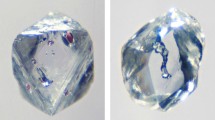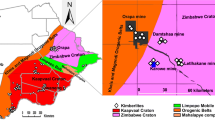Abstract
Trace element concentrations in the four principal peridotitic silicate phases (garnet, olivine, orthopyroxene, clinopyroxene) included in diamonds from Akwatia (Birim Field, Ghana) were determined using SIMS. Incompatible trace elements are hosted in garnet and clinopyroxene except for Sr which is equally distributed between orthopyroxene and garnet in harzburgitic paragenesis diamonds. The separation between lherzolitic and harzburgitic inclusion parageneses, which is commonly made using compositional fields for garnets in a CaO versus Cr2O3 diagram, is also apparent from the Ti and Sr contents in both olivine and garnet. Titanium is much higher in the lherzolitic and Sr in the harzburgitic inclusions. Chondrite normalised REE patterns of lherzolitic garnets are enriched (10–20 times chondrite) in HREE (LaN/YbN = 0.02–0.06) while harzburgitic garnets have sinusoidal REEN patterns, with the highest concentrations for Ce and Nd (2–8 times chondritic) and a minimum at Ho (0.2–0.7 times chondritic). Clinopyroxene inclusions show negative slopes with La enrichment 10–100 times chondritic and low Lu (0.1–1 times chondritic). Both a lherzolitic and a harzburgitic garnet with very high knorringite contents (14 and 21 wt% Cr2O3 respectively) could be readily distinguished from other garnets of their parageneses by much higher levels of LREE enrichment. The REE patterns for calculated melt compositions from lherzolitic garnet inclusions fall into the compositional field for kimberlitic-lamproitic and carbonatitic melts. Much more strongly fractionated REE patterns calculated from harzburgitic garnets, and low concentrations in Ti, Y, Zr, and Hf, differ significantly from known alkaline and carbonatitic melts and require a different agent. Equilibration temperatures for harzburgitic inclusions are generally below the C-H-O solidus of their paragenesis, those of lherzolitic inclusions are above. Crystallisation of harzburgitic diamonds from CO2-bearing melts or fluids may thus be excluded. Diamond inclusion chemistry and mineralogy also is inconsistent with known examples of metasomatism by H2O-rich melts. We therefore favour diamond precipitation by oxidation of CH4-rich fluids with highly fractionated trace element patterns which are possibly due to “chromatographic” fractionation processes.
Similar content being viewed by others
Author information
Authors and Affiliations
Additional information
Received: 27 January 1996 / Accepted: 5 May 1997
Rights and permissions
About this article
Cite this article
Stachel, T., Harris, J. Diamond precipitation and mantle metasomatism – evidence from the trace element chemistry of silicate inclusions in diamonds from Akwatia, Ghana. Contrib Mineral Petrol 129, 143–154 (1997). https://doi.org/10.1007/s004100050328
Issue Date:
DOI: https://doi.org/10.1007/s004100050328




